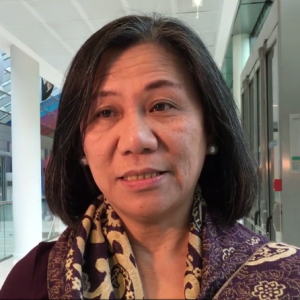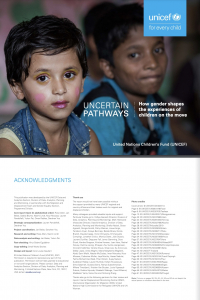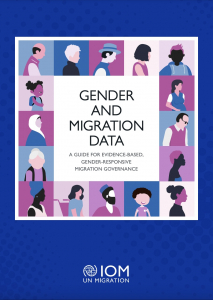Gender affects all aspects of the migration process due to gender roles, gender relations, expectations and power dynamics associated with a person’s gender identity. To capture the various needs of migrants of all genders, we need gender-sensitive data, which is also essential to inform evidence-based migration policy and programmes that benefit all.
According to UN DESA, as of mid-2020, female migrants made up 48.1 per cent (135 million) of the global international migrant stock while the overall share of female migrants has not varied significantly over the last 60 years. Female migrants, however, “can experience double discrimination as both migrants and as women” and migrants with diverse gender identities, such as LGBTQI+ migrants, face different forms of vulnerabilities and inequalities throughout the migration process (IOM, 2021). Gender mainstreaming in migration data means “assessing the implications for diverse migrants of all genders of any planned action, including legislation, policies or programmes in all areas and at all levels” (IOM, 2019). Gender mainstreaming is also closely tied to gender responsiveness which refers to “addressing the different needs, perspectives and representations of all genders” (IOM, 2021). Such processes go beyond breaking down data by sex to integrate a gendered perspective in the collection, production, use, analysis, and dissemination of migration data.
Here are four reasons why gender mainstreaming and responsiveness is essential in migration data.
(1) Gender matters to individual migration experiences
The experiences of migrants differ in their motivations and drivers for migration, migration pathways, routes, opportunities, resources available pre- and post-migration, as well as reintegration and return experiences. For example, the labor force participation of female migrants tends to differ significantly from their male counterparts. In 2019, according to the ILO, women made up 41.5 per cent of the total number of international migrant workers, while men constituted 58.5 per cent.1 This is partly due to the smaller percentage of women who are international migrants overall but can also be explained by the higher number of economic and non-economic obstacles that women face as migrant workers. For instance, admission schemes that target highly skilled migrants working in the technology sector, engineering, and finance, inadvertently favor male migrants as women tend to be less represented in these sectors (EIGE, 2021). Meanwhile, female migrant workers outnumber men in the service industry, mostly due to the growing labor demand in the care economy (ILO, 2019). Access to this data makes designing policy that benefits all migrant workers possible. States can adapt their labor migrant admission criteria to reflect a more equitable approach and one that is less likely to emit only one gender. Without such a gender analysis and mainstreaming in migration data, the experiences of certain groups of migrants become invisible and marginalized. Taking into consideration the varied gender experiences of migrant workers allows for the creation of data informed policies and programmes to meet the needs of migrants of all genders.
(2) The cost of gender blindness– exposing migrants to greater risks and risks in migration are correlated
A gendered analysis in migration exposes the unique opportunities, challenges, vulnerabilities, needs, and risks that migrants face depending on their diverse gender identities. Female migrants, for instance, are at a higher risk of exploitation, abuse and trafficking (ODI, 2016). This is partly due to their migration experiences as they are more likely to be employed in undervalued, less regulated, and less visible sectors such as domestic workers in private homes (ODI, 2016). An ongoing study from the World Bank also found that women are much more likely to get their information from informal channels. Data collected from 13,000+ Indonesians aged 18-40 suggested that “women are 25% more likely than men to say they would register through a broker and 38% less likely to say they would register with a government labor office” (World Bank, 2019). This is highly significant as the risks associated with irregular migration are much higher than those of formal migration, especially for women who are more likely to experience gender based and other forms of violence and risk becoming victims of financial exploitation, among others.
LGBTQI+ migrants, on the other hand, “may face intersecting discriminations: both as migrants as well as on the basis of their gender identity and/or sexual orientation” (IOM, 2021). During health crises, for example, such migrants are more likely to face discrimination and stigma when accessing health services (IOM, 2021). Further, LGBTGI+ asylum seekers have suffered abuse, sexual harassment and even rape in migrant facilities with most instances going unreported as migrants “fear it might look bad on their application case for refugee status” (World Economic Forum, 2018).
Migration policies must consider unique gendered risks to improve outcomes by providing gender-specific solutions to such vulnerabilities. If migration data is gender responsive governments, civil society, multilateral organizations, and any organization are better equipped to address the needs of migrants, promoting access to health, education, and justice for all.
(3) Gender is part of the global agendas
Not only does Objective One of the GCM call for migration data to be collected and to utilize accurate and disaggregated data as the basis for evidence-based policies, but the GCM also includes gender-responsiveness as a guiding principle for the Compact. Similarly, the SDGs include Target 17.18 which calls for “high-quality, timely and reliable data, disaggregated by income, gender, age, race, ethnicity, and migratory status.” Though not an extensive list, other SDGs with cross-cutting themes of gender and migration include Target 10.7 “to facilitate orderly, safe, regular and responsible migration and mobility of people, including through the implementation of planned and well-managed migration policies” as well as Targets 8.5, 8.7 and 8.8 focusing on labour migration. Such goals and targets rely on the collection and use of gender disaggregated data and policies to effectively benefit all populations. As the 2030 Agenda motto is “leave no one behind” gender mainstreaming and responsiveness is necessary to protect the rights of all migrants and for ensuring that no migrant is left behind.
(4) Including gender in data is a move toward gender equality and less discrimination
Gender responsive data can confront harmful gender stereotypes. For example, a study from The Women’s Refugee Commission found that sexual violence against men and boys was commonplace along the Central Mediterranean migration route. As relatively little is known about sexual abuse and exploitation among male migrants, more data is needed to adequately respond to such gender-based violence.
In the context of remittances, data from UN Women shows that while 100 million migrant women send remittances annually, migrant women pay on average 20 per cent more in transfer fees than men, largely due to barriers such as a lack of digital literacy and access to technology, leaving female migrants to rely on more expensive in-person cash transfer services (UN Women, 2020). In this respect, gender responsiveness would both highlight women’s contributions to their home country, as well as improve access to cheaper alternatives for remittances for women and increase social and economic benefits of societies of origin and destination.
The inclusion of gender in data collection can highlight vulnerabilities, gender challenges and gender issues; however, laws, policies, organizational, institutional and cultural capacities to respond and address these issues are often either still limited or non-existent.
Conclusion
For migration data to be more useful and equitable, it needs to be gender responsive. Targeting the specific needs of all migrants of all genders can bolster migrants’ agency and help reduce the risks and vulnerabilities at every step of the migration process. For migration to be safe and accessible to all, gender mainstreaming and responsiveness must be integrated into migration data collection, use, and analysis so that policymakers, national statistical offices (NSOs), and practitioners are better equipped in their decision making.







